油菜是重要的油料作物和能源作物,其在欧洲、加拿大、中国、印度、澳大利亚等均有大量种植,2011年加拿大油菜总产量超过中国,排在世界第一[1]。从过去五十年中国油菜的发展来看,油菜的单产水平持续增加,然而近十年来则基本处于停滞状态[2]。我国是世界上氮肥消费量最高的国家,年消费量占世界的30%以上[3],氮肥的粗放型管理,势必会引起一系列的资源与环境问题。近年来,由于施肥技术的改善、耕地面积减少等原因,使得农业氮肥用量增幅趋于平缓[2]。油菜是需肥量较高的作物,且氮肥利用率普遍低于其他作物[4],我国冬油菜对氮肥的依赖性高,从而导致氮肥投入高、利用率低[5]。
调查结果显示,长江流域冬油菜氮肥施用基本充足,但施用不足和过量施用的情况仍普遍存在,其中> 270 kg/hm2的农户比例约占15.8%[6]。盲目重施氮肥不仅无益于产量的提高,还会造成土壤肥力下降、生态环境污染等问题。土壤地力水平是决定目标产量的关键,肥料用量应依据土壤基础养分供应能力和作物需求规律进行协调[7]。国外在油菜施肥方面的研究普遍考虑土壤无机氮水平,但我国集约化种植条件下,土壤测试难以满足需求。多年多点油菜季缺素处理养分吸收量,可作为区域土壤基础养分供应能力的重要参考[8]。
在国家提出“到2020年化肥使用量零增长”目标的背景下[9],氮肥用量的零增长可能是首要任务。如何在稳定冬油菜产量的前提下减少氮肥的施用,仍然存在技术难关;如何在提高冬油菜产量的前提下减少氮肥的施用,需不断突破技术瓶颈。通过结合文献数据库、统计数据库、试验数据库,分析国内外油菜产量差及氮肥效率差,明确我国油菜产业的节氮潜力,并基于不同地力条件,估算国内油菜生产达到国外不同水平情景下的节氮潜力,探讨国内外油菜生产中的差异,以期为我国油菜产业的氮肥减施增效提供理论依据和技术途径。
1 材料与方法 1.1 数据来源统计数据:不同国家2005~2014年油菜产量数据来源于FAO统计数据库[1],中国各省 (市) 2005~2014年油菜产量、种植面积来源于国家统计局统计数据库[2]。
文献数据库:德国、英国、波兰、澳大利亚和印度的油菜产量和氮肥用量数据来源于Web of Science,通过输入油菜 (rapeseed/oilseed rape)、施肥 (fertilization) 和产量 (yield) 等主题检索出2000年至今的文献58篇,整理并筛选出包含产量、氮肥用量等信息完整的有效文献16篇。
国内油菜数据库:来源于本课题组油菜调查数据库 (2009~2011年) 和油菜施肥效果数据库 (2005~2015年)。
1.2 数据处理氮肥偏生产力 (PFPN,kg/kg) = 油菜产量 (kg/hm2)/氮肥用量 (kg/hm2)
氮肥需求量 (× 104 t) = 单位面积氮肥用量 (kg/hm2) × 油菜种植面积 (× 103 hm2) × 10–4
产量趋势[10] [kg/(hm2·a)]:选用线性回归模型,拟合2005~2014年的油菜产量,方程斜率即为产量趋势。
土壤供应氮素能力 (soil indigenous nitrogen supply,INS):土壤养分含量是反映土壤肥力最直接的指标,而在大区域范围内这些指标往往与作物生长或产量的相关性较差[11],以缺素处理作物产量或养分吸收量表示土壤基础养分供应能力得到越来越多的应用和推广[8, 12–13]。根据本课题组大范围冬油菜肥料试验结果[14]可知,直播和移栽冬油菜的基础吸氮量平均分别为N 42.2和53.5 kg/hm2,均值约为N 50 kg/hm2,以该值作为冬油菜主产区土壤供应氮素能力的平均水平,上下增减N 20 kg/hm2分别设置为高等和低等土壤供氮能力,即将冬油菜基础吸氮量30、50、70 kg/hm2定义为土壤供氮能力低、中、高三个水平 (对应的油菜产量分别约为500、1000和1500 kg/hm2)。土壤供氮能力的高低是决定潜在目标产量的关键,参考王寅[14]的研究,利用QUEFTS模型确定高、中、低三个等级的土壤供氮能力所对应的潜在目标产量为5000、4000、3000 kg/hm2。
情景分析:以国内农户调查为基础,设置推荐水平 (对应的施氮量为最佳经济施氮量) 为情景Ⅰ。综合国内冬油菜氮肥偏生产力水平 (12.2 kg/kg) 与国外较高水平 (26.4 kg/kg) 相差约15个单位,以氮肥偏生产力每增加5个单位为一个情景,划分三个情景 (Ⅱ、Ⅲ、Ⅳ),即国外一般水平、中等水平和较高水平,估算中国冬油菜减氮潜力。
数据采用Microsoft Excel 2013软件进行统计,Origin 8和ArcGIS 9.3软件进行绘图。
2 结果与分析 2.1 国内外油菜产量与氮肥偏生产力根据FAO统计数据[1],筛选出总产和单产均较高的油菜种植典型国家,包括德国、英国、法国、捷克和波兰,以及单产水平与中国接近的加拿大和低于中国水平的澳大利亚、印度 (图1)。结果显示,近十年油菜平均单产以德国最高,约3800 kg/hm2,其次为英国、法国和捷克,超过3000 kg/hm2,均高于欧洲平均水平 (2500 kg/hm2),加拿大和中国约为1800 kg/hm2,略低于全球平均水平 (2000 kg/hm2),而澳大利亚和印度仅为1100 kg/hm2。从油菜产量趋势来看,欧洲油菜整体发展较快,近十年年均增产约50 kg/hm2,约为世界平均水平的两倍,其中法国最高,达到60 kg/(hm2·a) 以上,中国和印度较低,约为12 kg/(hm2·a)。
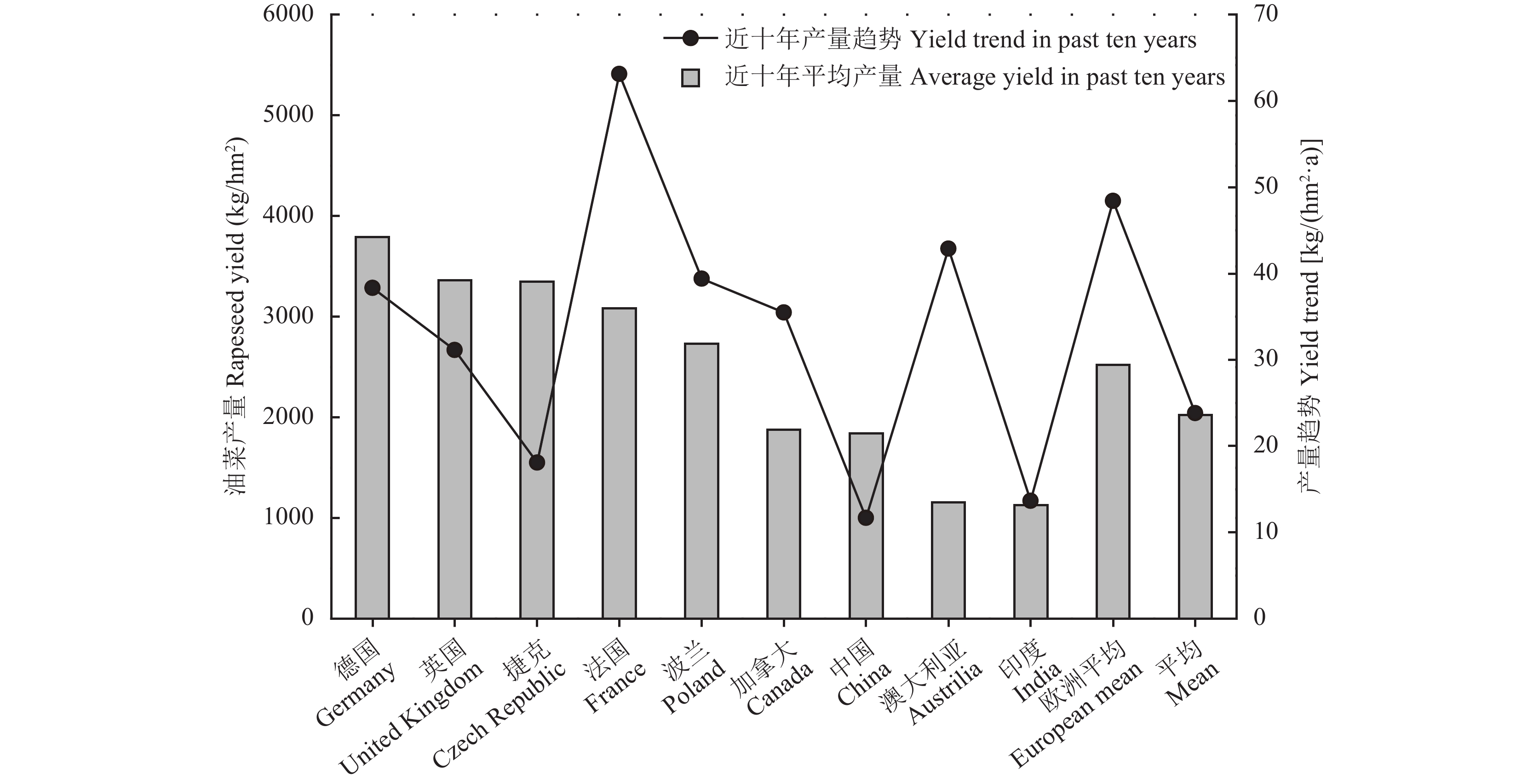 |
| 图1 不同国家的油菜产量 Fig. 1 Oilseed rape yields in different countries |
通过搜集到的德国、英国、波兰、澳大利亚、加拿大、印度和中国的油菜氮肥用量与产量,计算出对应的氮肥偏生产力(表1)。统计结果显示,发达国家油菜氮肥用量平均为70~194 kg/hm2,其中以澳大利亚和加拿大较低,欧洲国家 (德国、英国、波兰) 相对较高,对应的氮肥偏生产力变幅为23.4~27.9 kg/kg,均属于较高水平;印度氮肥用量平均为113 kg/hm2,由于单产水平较低,其氮肥偏生产力仅为8.2 kg/kg;中国氮肥用量与欧洲国家相当,而氮肥偏生产力为12.2 kg/kg,明显低于发达国家。分析中国冬油菜用量的两篇大区域尺度文献可知,Li等[12]收集了长江流域1457个当地农技人员推荐的冬油菜样本,徐华丽[6]调查了长江流域1848个农户的冬油菜样本,前者氮肥用量低于后者,而产量高于后者,说明中国油菜氮肥用量有明显的减施空间,且在提高油菜产量的同时可以提高肥料利用率。
| 表1 不同国家的油菜氮肥用量与偏生产力 Table 1 Nitrogen rates and partial factor productivity of oilseed rape in different countries |
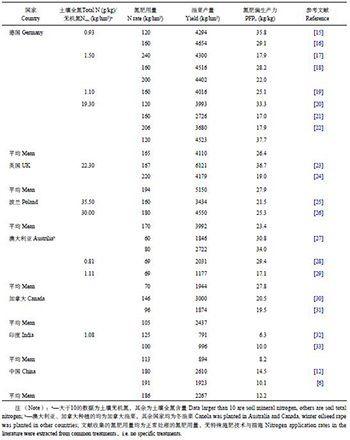 |
根据国家统计局统计年鉴数据[2],绘制了近十年国内冬油菜主产省 (市) 油菜平均产量和产量趋势分布图 (图2)。统计结果显示,空间趋势整体表现为长江下游高于上游,长江以北高于长江以南;产量主要分布在1500~2100 kg/hm2,四川和江苏产量较高 (> 2100 kg/hm2),江西较低 (< 1200 kg/hm2)。产量趋势结果表明,近十年年均增幅较高的省份均在长江中下游,江西、安徽、江苏增幅均 > 30 kg/(hm 2·a),其次为四川 [20~30 kg/(hm2·a)],而浙江近十年产量处于停滞状态,其他省份年增幅较为一般 [0~20 kg/(hm2·a)]。
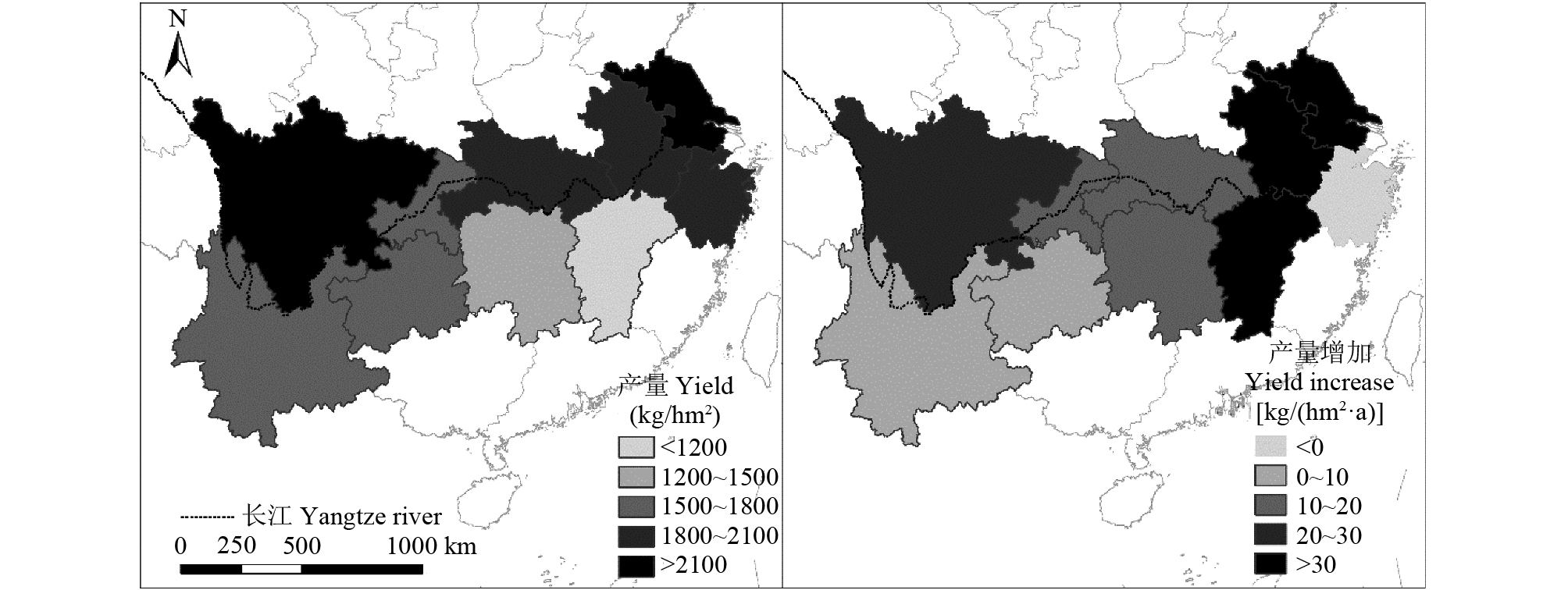 |
| 图2 中国冬油菜主产区的油菜产量 Fig. 2 Winter oilseed rape yields in the main production provinces of China |
为探明我国冬油菜氮肥施用状况,本文结合冬油菜主产省 (市) 3000多份调查问卷和测土配方施肥项目1400多个肥料试验数据库资料,得到农户水平和推荐水平下氮肥用量、油菜产量和氮肥偏生产力 (表2)。统计结果表明,农户水平氮肥用量平均变幅为152~255 kg/hm2,其中以江西最低,江苏和浙江较高,其余省份主要集中在 (180 ± 10) kg/hm2;产量平均变幅为1722~2360 kg/hm2,整体趋势与年鉴中近十年各省 (市) 结果相似;氮肥偏生产力主要集中在 (10 ± 1.5) kg/kg,其中以湖南和江苏较低 (约9.0 kg/kg),四川、湖北和江西较高 (约12.0 kg/kg)。推荐水平氮肥用量较农户水平有所降低,最低为重庆 (141 kg/hm2),最高为江苏 (190 kg/hm2),其余省份主要集中在 (165 ± 10) kg/hm2;油菜产量和氮肥偏生产力较农户水平均有明显提高,对应分别集中在2300~2700 kg/hm2和15~17 kg/kg,其中江苏由于氮肥用量较高,其氮肥效率明显低于其他省份。
| 表2 中国冬油菜主产区的油菜氮肥用量和偏生产力 Table 2 Nitrogen rates and partial factor productivity of winter oilseed rape in the main production provinces of China |
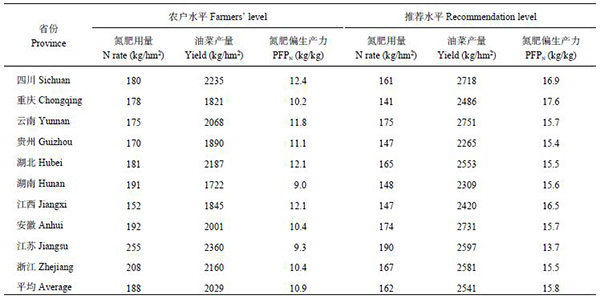 |
通过对比农户水平和推荐水平油菜施氮量 (表2) 可知,单位面积节氮量较高的省份有江苏、湖南、浙江、重庆等。结合冬油菜种植面积[2],评估各省 (市) 氮肥需求量和节氮潜力如表3所示。农户水平氮肥需求总量为115.6 × 104 t,其中以湖南、湖北、四川需求量最高 (约20 × 104 t),浙江、重庆、云南需求量最低 (约4 × 104 t);推荐水平氮肥需求量共99.6 × 104 t,较农户水平施氮量可节省16.0 × 104 t,节氮潜力较高的省份有湖南、江苏、湖北、四川。其中,湖南由于单位面积节氮水平 (43 kg/hm2) 和油菜种植面积 (129.8万hm2) 均较高而排名首位,江苏以单位面积节氮水平最大 (65 kg/hm2) 而突显节氮潜力,湖北和四川均以油菜种植面积较大而具备较高的节氮潜力。说明针对不同省份,油菜的节氮途径应有相应调整。
| 表3 中国冬油菜主产区的油菜节氮潜力评估 Table 3 Nitrogen saving potential for winter oilseed rape in the main production provinces of China |
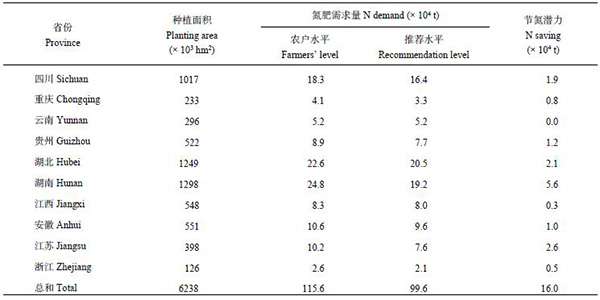 |
基于QUEFTS模型[14]计算的不同情景下达到目标产量时的单位面积氮肥需求量(图3),随着目标产量的提高,氮肥用量逐渐增加;不同情景模式下,国内推荐水平在目标产量较高时,氮肥需求量急剧增加。图中竖线表示国内农户施肥水平,竖线左侧表示不同情景模式下获得目标产量时可达到节省氮肥的效果,右侧则表示需要在农户施肥的水平上增施氮肥。
 |
| 图3 不同土壤供氮能力下达到目标产量所需的氮肥量 Fig. 3 Nitrogen demands for the target yields under different soil indigenous nitrogen supply (INS) [注 (Note):图中竖线为农户水平氮肥用量,即188 kg/hm2。(a) 土壤供氮能力为30 kg/hm2,潜在目标产量为3000 kg/hm2;(b) 土壤供氮能力为50 kg/hm2,潜在目标产量为4000 kg/hm2;(c) 土壤供氮能力为70 kg/hm2,潜在目标产量为5000 kg/hm2。Vertical bars represent the farmers’ nitrogen level,i.e., 188 kg/hm2. (a) INS = 30 kg/hm2,potential target yield = 3000 kg/hm2; (b) INS = 50 kg/hm2, potential target yield = 4000 kg/hm2; (c) INS = 70 kg/hm2, potential target yield = 5000 kg/hm2.] |
以农户水平氮肥需求量 (115.6 × 104 t) 为基础,分析不同情景下达到目标产量时的节氮潜力 (表4)。情景I,在国内推荐施肥的水平下,若土壤供氮能力较低,目标产量超过2250 kg/hm2时,氮肥减施空间将低于0;土壤供氮能力为中等、目标产量为2500kg/hm2时,理论节氮潜力为16万t,与实际推荐水平的节氮潜力 (16.0万t,表3) 相当;随着土壤供氮能力的提高,节氮潜力明显增加。情景II,氮肥偏生产力提高5个单位达到国外一般水平,不同土壤供氮能力下,油菜产量达到3000 kg/hm2时的节氮潜力分别为 –32 × 104、12 × 104、26 × 104 t,说明目标产量为3000 kg/hm2时,需要中等或较高的地力水平才能达到氮肥减施的目标。情景III,氮肥偏生产力再提高5个单位达到国外中等水平,产量水平达到3500 kg/hm2,中等地力可节氮8 × 104 t,高等地力则为23 × 104 t。情景IV,氮肥偏生产力继续提高5个单位达到国外较高水平,目标产量可达到4000 kg/hm2,此时仍有节氮空间。表明在目前国内推荐施肥的水平下,土壤基础供氮能力是节氮增产的主要制约性因素,为了进一步提高油菜目标产量,需要不断地提高肥料利用率,才能达到氮肥减施增效的目标。
| 表4 未来不同情境下油菜高产高效节氮潜力评估 Table 4 Evaluation of nitrogen saving potential for high yield and high efficiency of winter oilseed rape under different scenarios in the future |
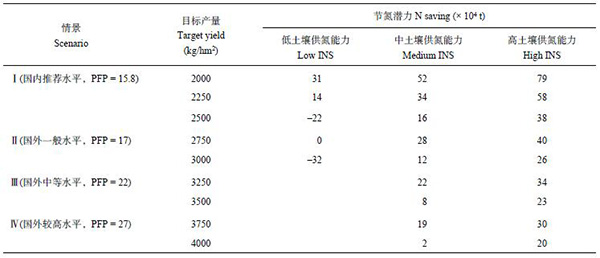 |
欧洲各国油菜生育期内的气候条件较为接近,年平均气温在9℃左右 (春油菜季和冬油菜季分别为14 ℃和6 ℃),年降水量约为600 mm (春油菜季和冬油菜季分别为250 mm和350 mm);我国冬油菜主产区长江流域,油菜生育期 (220天左右[34]) 气温和降水量分别为13℃和650 mm[35]。国内外的气候差异直接导致油菜品种特性和种植制度的不同,从而引起产量差和技术效率差。在轮作模式方面,国外往往以多年为一个轮作周期[22],周期中包括春油菜和冬油菜,以及豌豆等豆科作物和小麦等粮食作物[36];在我国,轮作周期往往为一年,春油菜区以一年一熟为主,冬油菜区主要与粮食作物轮作,如长江流域冬油菜与水稻、玉米等轮作,对土壤养分的耗竭较大。在品种选择方面,国外有常规品种、杂交品种和半矮秆杂交品种[37],另外,加拿大油菜全部为春油菜,生育期仅100~110天左右,澳大利亚以甘蓝型夏油菜为主;国内油菜品种基本形成双低、高产、多抗的品种特色[38],由于生态环境的差异,春油菜品种有青海省的青杂系列,甘肃省的陇油系列,冬油菜区长江上游有蓉油、德油系列,中游有华油杂、湘油杂、赣油杂系列,下游有扬油、浙双系列,另外有中双、中油杂系列等,但区域局限性较大,且不同区域由于气候条件和种植制度的差异,油菜生育期变幅约为187~255天[34]。在栽培管理技术方面,国外普遍采用全程机械化,播种密度为30~80株/m2,而国内机械化水平不高,农户多采用人工播种或移栽,直播和移栽密度约为30~45和9~12万株/hm2;国外施肥充分考虑土壤的基础养分供应能力以确定氮肥的基肥用量,磷、钾肥用量普遍较低,均作为基肥施用,且重视硫肥的施用,而国内施肥多以经验为主,重施氮肥,忽视磷、钾肥,常施用硼肥以防土壤缺硼,另外,也有施用锌肥增产的报道[39]。
3.2 我国冬油菜氮肥施用存在的问题及解决途径过量施肥是肥料利用率低的最主要原因[40],完善和改进配套的施肥技术,并以此应用到田间实际生产,是维持作物产量的同时减少肥料施用的关键。针对我国油菜氮肥施用时存在的问题,提出以下措施为实现氮肥减施增效提供科学依据。
农户在播种或移栽前,多采用撒施的方式施用,并对表层土壤进行翻扒,相比而言,集中施用更能减少氮素损失。同等氮肥用量和运筹下,直播条施或移栽穴施较表面撒施可获得更高的产量和氮肥利用率[41]。基施深度一般控制在8~10 cm左右,过浅可能会抑制苗期根系的生长,难以满足后期养分需求;过深时氮肥残留多、利用率低,且劳动成本高[42–43]。
基于不同田块对氮肥的响应,我国油菜氮肥推荐用量约为90~325 kg/hm2[7],区域适宜氮肥用量的确定也有不同的推荐方法,如肥料效应函数法、氮素营养诊断等。研究表明,基于土壤供氮能力优化氮肥用量,湖北省水稻在无产量损失的同时,氮肥用量可减少12%[11];随着土壤基础供氮能力的提高,长江流域油菜最佳氮肥用量由200 kg/hm2降低到162 kg/hm2[12]。因此,以土壤供氮能力为基础,进一步调整区域氮肥用量将有助于氮肥减量增效。
油菜氮素吸收可分为吸收期和降低期[44],吸收期包括苗期、越冬肥和蕾薹期,降低期的分界点约从花期开始,因此,氮肥施用时期可分为基肥、苗肥、越冬肥、蕾薹肥和花肥,其中追施花肥增产效果不明显[45],且不易操作。针对油菜不同时期对氮素的需求,氮肥施用次数有1~4次,普遍推荐基肥50%~60%、越冬肥 (苗肥) 20%和薹肥20%~30%施用[7]。
我国尿素消费量占总氮肥的70%左右,氮肥形态单一,而欧洲油菜主要氮肥来源以硝酸铵钙为主[3]。有研究表明,纯铵态氮肥或硝态氮肥与尿素处理相比,油菜产量无明显提高,但不同硝铵配比可影响油菜根系构型,其中以硝铵比为1∶3时效果最佳[43]。另外,高效氮肥如缓/控释氮肥、添加硝化/脲酶抑制剂的氮肥和专用配方肥等,在不同作物上的研究均表现出降低劳动成本、减少氮素损失、提高氮肥利用率的效果[47–48]。从目前的研究来看,秸秆还田的增产效果存在一定的争议[49]。相同施肥条件下,长期秸秆还田可使油菜获得较为稳定的增产效果[50]。针对不同轮作,油菜前茬一般有水稻、玉米、棉花等秸秆,由于不同还田秸秆腐解速率及氮素供应量的差异,往往需要结合氮肥运筹技术,从而达到氮肥减施的目标。有机肥常与化肥配施,有研究显示有机肥比例为10% 时,油菜产量较高,但由于研究的局限性,该比例可能需要进一步研究确定[51]。
合理增加直播油菜种植密度可节省氮肥的施用,且能获得油菜的高产。油菜越冬期气候干燥、寒冷,生长缓慢,高密度可维持较高的存活率,从而保证收获密度。油菜产量随种植密度的增加表现为先增加后降低,高氮高密度可能会减少有效光合面积及透光率,抑制生长[52]。在相同的目标产量下,油菜增密种植可减少22.9%~30.6%的氮肥用量[53]。
3.3 稻油轮作中油菜施肥与栽培技术水稻–油菜轮作是长江中下游主要的轮作制度之一,针对稻油轮作中油菜氮肥减施提出以下配套栽培措施。直播种植密度一般在25~30株/m2左右,可增密到40株/m2左右,移栽种植密度一般在5~8株/m2左右,可增密到12株/m2左右;生育前期保证氮肥充足供应,以保证幼苗发育和存活,即氮肥适当前移;配合磷肥约50~80 kg/hm2,钾肥约75~90 kg/hm2,硼肥约10~15 kg/hm2,均采用基施;肥料基施深度在10 cm左右;选择合适的氮肥形态,如硝铵比为1∶3或缓控释肥和尿素比例为6∶4。
4 结论目前我国油菜产量约为1800 kg/hm2,低于世界平均水平,且近十年处于停滞状态,其中长江流域冬油菜各主产省产量差异较大,主要集中在1500~2100 kg/hm2。氮肥用量与欧洲平均水平相当,但氮肥偏生产力远低于发达国家;农户水平氮肥需求量约为116 × 104 t,根据当前国内推荐施氮水平可节省16.0 × 104 t氮。地力水平是一定区域范围内节氮潜力的主要制约因素,对于当前的油菜品种,随着目标产量的提高,需不断改善相应的氮素管理策略,才能进一步减少氮肥的施用,提高氮肥利用率。
| [1] | FAO. FAOSTAT[EB/OL]. http://faostat.fao.org, 2016. |
| [2] |
中华人民共和国国家统计局. 2016中国统计年鉴[EB/OL]. http://www.stats.gov.cn, 2016.
National Bureau of Statistics of China. China statistical yearbook[EB/OL]. http://www.stats.gov.cn, 2016. |
| [3] | IFA. IFADATA[EB/OL]. http://ifadata.fertilizer.org, 2016. |
| [4] | Bouchet A S, Laperche A, Bissuel–Belaygue C, et al. Nitrogen use efficiency in rapeseed. A review[J]. Agronomy for Sustainable Development, 2016, 36(2): 1–20. |
| [5] |
鲁剑巍. 中国油菜生产的高产高效氮素管理[J].
中国农业科学, 2016, 49(18): 3504–3505.
Lu J W. Nitrogen management with high yield and high efficiency for oilseed rape in China[J]. Scientia Agricultura Sinica, 2016, 49(18): 3504–3505. |
| [6] |
徐华丽. 长江流域油菜施肥状况调查及配方施肥效果研究[D]. 武汉: 华中农业大学硕士学位论文, 2012.
Xu H L. Investigation on fertilization and effect of formulated fertilization of winter rapeseed in Yangtze River Basin[D]. Wuhan: MS Thesis of Huazhong Agricultural University, 2012. |
| [7] |
任涛, 鲁剑巍. 中国冬油菜氮素养分管理策略[J].
中国农业科学, 2016, 49(18): 3506–3521.
Ren T, Lu J W. Integrated nitrogen management strategy for winter oilseed rape (Brassica napus L.) in China [J]. Scientia Agricultura Sinica, 2016, 49(18): 3506–3521. |
| [8] | Dobermann A, Witt C, Abdulrachman S, et al. Soil fertility and indigenous nutrient supply in irrigated rice domains of Asia[J]. Agronomy Journal, 2003, 95(4): 913–923. |
| [9] |
中华人民共和国农业部. 到2020年化肥使用量零增长行动方案[EB/OL]. http://www.moa.gov.cn, 2015.
Ministry of Agriculture of China. Achieving zero growth in synthetic fertilizer use by 2020[EB/OL]. http://www.moa.gov.cn, 2015. |
| [10] | Ray D K, Ramankutty N, Mueller N D, et al. Recent patterns of crop yield growth and stagnation[J]. Nature Communications, 2012, 3(4): 187–190. |
| [11] | Wang W, Lu J, Tao R, et al. Evaluating regional mean optimal nitrogen rates in combination with indigenous nitrogen supply for rice production[J]. Field Crops Research, 2012, 137: 37–48. |
| [12] | Li H, Cong R, Ren T, et al. Yield response to N fertilizer and optimum N rate of winter oilseed rape under different soil indigenous N supplies[J]. Field Crops Research, 2015, 181: 52–59. |
| [13] | Cong R, Li H, Zhang Z, et al. Evaluate regional potassium fertilization strategy of winter oilseed rape under intensive cropping systems: Large-scale field experiment analysis[J]. Field Crops Research, 2016, 193: 34–42. |
| [14] |
王寅. 直播和移栽冬油菜氮磷钾肥施用效果的差异及机理研究[D]. 武汉: 华中农业大学博士学位论文, 2014.
Wang Y. Study on the different responses to nitrogen, phosphorus, and potassium fertilizers and the mechanisms between direct sown and transplanted winter oilseed rape [D]. Wuhan: PhD Dissertation of Huazhong Agricultural University, 2014. |
| [15] | Rathke G W, Christen O, Diepenbrock W. Effects of nitrogen source and rate on productivity and quality of winter oilseed rape (Brassica napus, L.) grown in different crop rotations [J]. Field Crops Research, 2005, 94(2-3): 103–113. |
| [16] | Rathke G W, Behrens T, Diepenbrock W. Integrated nitrogen management strategies to improve seed yield, oil content and nitrogen efficiency of winter oilseed rape (Brassica napus, L.): A review [J]. Agriculture Ecosystems and Environment, 2006, 117(2-3): 80–108. |
| [17] | Ulas A, Erley G S A, Kamh M, et al. Root-growth characteristics contributing to genotypic variation in nitrogen efficiency of oilseed rape[J]. Journal of Plant Nutrition and Soil Science, 2012, 175(3): 489–498. |
| [18] | Pahlmann I, Böttcher U, Sieling K, et al. Possible impact of the Renewable Energy Directive on N fertilization intensity and yield of winter oilseed rape in different cropping systems[J]. Biomass and Bioenergy, 2013, 57(4): 168–179. |
| [19] | Sieling K, Kang N, Kage H. Application of pig slurry—First year and residual effects on yield and N balance[J]. European Journal of Agronomy, 2014, 59: 13–21. |
| [20] | Ulas A, Behrens T, Wiesler F, et al. Defoliation affects seed yield but not N uptake and growth rate in two oilseed rape cultivars differing in post-flowering N uptake[J]. Field Crops Research, 2015, 179: 1–5. |
| [21] | Findeklee F K, Horst W. Contribution of nitrogen uptake and retranslocation during reproductive growth to the nitrogen efficiency of winter oilseed-rape cultivars (Brassica napus L.) differing in leaf senescence [J]. Agronomy, 2016, 6(1): 1. |
| [22] | Hegewald H, Koblenz B, Wenschdorendorf M, et al. Impacts of high intensity crop rotation and N management on oilseed rape productivity in Germany[J]. Crop and Pasture Science, 2016, 67(3–4): 439–449. |
| [23] | White C A, Roques S E, Berry P M. Effects of foliar-applied nitrogen fertilizer on oilseed rape (Brassica napus) [J]. Journal of Agricultural Science, 2013, 153(1): 42–55. |
| [24] | Roques S E, Berry P M. The yield response of oilseed rape to plant population density[J]. Journal of Agricultural Science, 2015, 154(2): 1–16. |
| [25] | Barlog P, Grzebisz W. Effect of timing and nitrogen fertilizer application on winter oilseed rape (Brassica napus, L.). I. Growth dynamics and seed yield [J]. Journal of Agronomy and Crop Science, 2004, 190(5): 305–313. |
| [26] | Jankowski K J, Budzyński W S, Załuski D, et al. Using a fractional factorial design to evaluate the effect of the intensity of agronomic practices on the yield of different winter oilseed rape morphotypes[J]. Field Crops Research, 2016, 188: 50–61. |
| [27] | Hocking P J, Mead J A, Good A J, et al. The response of canola (Brassica napus L.) to tillage and fertiliser placement in contrasting environments in southern NSW [J]. Australian Journal of Experimental Agriculture, 2003, 43(11): 1323–1335. |
| [28] | Brennan R F, Bolland M D A. Influence of potassium and nitrogen fertiliser on yield, oil and protein concentration of canola (Brassica napus L.) grain harvested in south-western Australia [J]. Australian Journal of Experimental Agriculture, 2007, 47(8): 976–983. |
| [29] | Brennan R F, Bolland M D A. Comparing the nitrogen and phosphorus requirements of canola and wheat for grain yield and quality[J]. Crop and Pasture Science, 2009, 60(6): 566–577. |
| [30] | Gan Y, Blackshaw R E, May W E, et al. Yield stability and seed shattering characteristics of canola in the northern great plains[J]. Crop Science, 2016, 56(3): 1296–1305. |
| [31] | Syrovy L D, Shirtliffe S J, Zarnstorff M E. Yield response to early defoliation in spring-planted canola[J]. Crop Science, 2016, 56(4): 1981–1987. |
| [32] | Buttar G S, Thind H S, Aujla M S. Methods of planting and irrigation at various levels of nitrogen affect the seed yield and water use efficiency in transplanted oilseed rape (Brassica napus, L.) [J]. Agricultural Water Management, 2006, 85(3): 253–260. |
| [33] | Sardana V, Sheoran P. Production potential of canola oilseed rape (Brassica napus) cultivars in response to nitrogen and sulphur nutrition [J]. Indian Journal of Agricultural Sciences, 2011, 81(3): 280–282. |
| [34] |
王寅, 鲁剑巍. 中国冬油菜栽培方式变迁与相应的养分管理策略[J].
中国农业科学, 2015, 48(15): 2952–2966.
Wang Y, Lu J W. The transitional cultivation patterns of winter oilseed rape in China and the corresponding nutrient management strategies[J]. Scientia Agricultura Sinica, 2015, 48(15): 2952–2966. |
| [35] |
中国气象数据网. 中国地面气候资料日值数据集[EB/OL]. http://data.cma.cn/, 2015.
Data of China Meteorological Administration. Daily climate dataset in China[EB/OL]. http://data.cma.cn/, 2015. |
| [36] | Sieling K, Christen O. Crop rotation effects on yield of oilseed rape, wheat and barley and residual effects on the subsequent wheat[J]. Archives of Agronomy and Soil Science, 2015, 61(11): 1531–1549. |
| [37] | Roques S E, Berry P M. The yield response of oilseed rape to plant population density[J]. Journal of Agricultural Science, 2015, 154(2): 1–16. |
| [38] |
王汉中. 中国油菜品种改良的中长期发展战略[J].
中国油料作物学报, 2004, 26(3): 98–101.
Wang H Z. Medium-term and long-term developing stratagem of variety improvement of China rape[J]. Chinese Journal of Oil Crop Sciences, 2004, 26(3): 98–101. |
| [39] | Wang Y, Li J, Gao X, et al. Winter oilseed rape productivity and nutritional quality responses to zinc fertilization[J]. Agronomy Journal, 2014, 106(4): 1349–1357. |
| [40] |
张福锁, 王激清, 张卫峰. 中国主要粮食作物肥料利用率现状与提高途径[J].
土壤学报, 2008, 45(5): 915–924.
Zhang F S, Wang J Q, Zhang W F, et al. Nutrient use efficiencies of major cereal crops in China and measures for improvement[J]. Acta Pedologica Sinica, 2008, 45(5): 915–924. |
| [41] |
余常兵, 谢立华, 胡小加, 等. 油菜氮肥的轻简施用技术[J].
中国油料作物学报, 2012, 34(6): 633–637.
Yu C B, Xie L H, Hu X J, et al. Simplified application technique of nitrogen fertilizer on rapeseed[J]. Chinese Journal of Oil Crop Sciences, 2012, 34(6): 633–637. |
| [42] |
苏伟. 油菜轻简化生产中几项养分管理关键技术的初步研究[D]. 武汉: 华中农业大学硕士学位论文, 2010.
Su W. Preliminary study on several crucial technologies about nutrient management of simplified cultivation of rapeseed [D]. Wuhan: MS Thesis of Huazhong Agricultural University, 2010. |
| [43] |
张岳芳, 周炜, 王子臣, 等. 氮肥施用方式对油菜生长季氧化亚氮排放的影响[J].
农业环境科学学报, 2013, 32(8): 1690–1696.
Zhang Y F, Zhou W, Wang Z C, et al. Effects of nitrogen fertilizer application modes on nitrous oxide emissions during growing season of oilseed rape (Brassica napus) [J]. Journal of Agro-Environment Science, 2013, 32(8): 1690–1696. |
| [44] |
刘晓伟. 冬油菜养分吸收规律及不同养分效率品种特征比较研究[D]. 武汉: 华中农业大学硕士学位论文, 2011.
Liu X W. Study on nutrient absorption of oilseed rape and characteristics compare in different nutrient efficiency types [D]. Wuhan: MS Thesis of Huazhong Agricultural University, 2011. |
| [45] |
韩自行, 张长生, 王积军, 等. 氮肥运筹对稻茬免耕油菜农艺性状及产量的影响[J].
作物学报, 2011, 37(12): 2261–2268.
Han Z H, Zhang C S, Wang J J, et al. Effects of nitrogen application on agronomic traits and yield of rapeseed in no-tillage rice stubble field[J]. Acta Agronomica Sinica, 2011, 37(12): 2261–2268. |
| [46] |
张萌. 不同形态氮肥配施对直播冬油菜生长、根系形态及光合特性的影响[D]. 武汉: 华中农业大学硕士学位论文, 2015.
Zhang M. Effects of nitrogen forms on the growth, root morphology and photosynthetic characteristics of direct sown winter oilseed rape[D]. Wuhan: MS Thesis of Huazhong Agricultural University, 2015. |
| [47] |
孙志梅, 张阔, 刘建涛, 等. 氮肥调控剂对潮褐土中不同氮源氮素转化及油菜生长的影响[J].
应用生态学报, 2012, 23(9): 2497–2503.
Sun Z M, Zhang K, Liu J T, et al. Effects of nitrogen regulators on fertilizer nitrogen transformation in meadow cinnamon soil[J]. Chinese Journal of Applied Ecology, 2012, 23(9): 2497–2503. |
| [48] |
李小坤, 王素萍, 鲁剑巍, 等. 多元长效油菜专用肥的适宜用量研究[J].
中国油料作物学报, 2011, 33(6): 593–597.
Li X K, Wang S P, Lu J W, et al. Application quantity of multi-nutrient and long-effect special fertilizer for rapeseed[J]. Chinese Journal of Oil Crop Sciences, 2011, 33(6): 593–597. |
| [49] |
张维乐, 戴志刚, 任涛, 等. 不同水旱轮作体系秸秆还田与氮肥运筹对作物产量及养分吸收利用的影响[J].
中国农业科学, 2016, 49(7): 1254–1266.
Zhang W L, Dai Z G, Ren T, et al. Effects of nitrogen fertilization managements with residues incorporation on crops yield and nutrients uptake under different paddy-upland rotation systems[J]. Scientia Agricultura Sinica, 2016, 49(7): 1254–1266. |
| [50] |
刘禹池, 曾祥忠, 冯文强, 等. 稻–油轮作下长期秸秆还田与施肥对作物产量和土壤理化性状的影响[J].
植物营养与肥料学报, 2014, 20(6): 1450–1459.
Liu Y C, Zeng X Z, Feng W Q, et al. Effects of long-term straw mulch and fertilization on crop yields and soil physical and chemical properties under rice-rapeseed rotation[J]. Journal of Plant Nutrition and Fertilizer, 2014, 20(6): 1450–1459. |
| [51] |
田昌, 彭建伟, 宋海星, 等. 有机肥化肥配施对冬油菜养分吸收、籽粒产量和品质的影响[J].
中国土壤与肥料, 2012, (4): 70–74.
Tian C, Peng J W, Song H X, et al. Effect of organic manure fertilizer on winter rapeseed nutrient uptake, grain yield and quality[J]. Soil and Fertilizer Sciences in China, 2012, (4): 70–74. |
| [52] |
杨士芬. 氮肥和密度对直播冬油菜冠层结构及群体特征的影响[D]. 武汉: 华中农业大学硕士学位论文, 2014.
Yang S F. Effect of nitrogen fertilizer and planting density on canopy structure and population characteristic of winter rapeseed with direct seeding treatment [D]. Wuhan: MS Thesis of Huazhong Agricultural University, 2014. |
| [53] |
朱珊, 李银水, 余常兵, 等. 密度和氮肥用量对油菜产量及氮肥利用率的影响[J].
中国油料作物学报, 2013, 35(2): 179–184.
Zhu S, Li Y S, Yu C B, et al. Effects of planting density and nitrogen application on rapeseed yield and nitrogen efficiency[J]. Chinese Journal of Oil Crop Sciences, 2013, 35(2): 179–184. |
 2017, Vol. 23
2017, Vol. 23  doi:
doi: 

